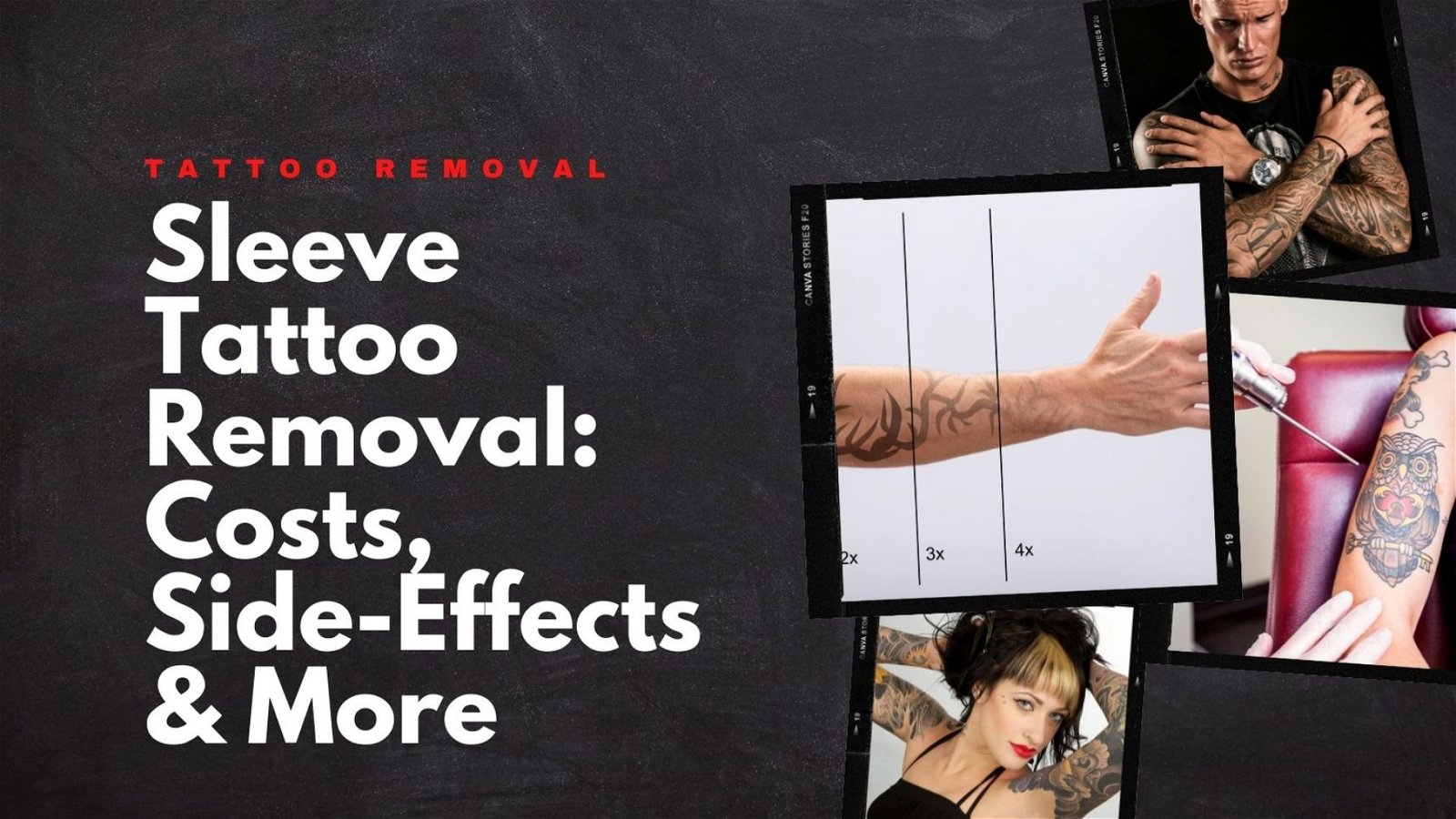Are you in your more mature years and regretting your tattoo sleeve from your past life? Or, maybe you’ve just grown out of your tattoo sleeve and want it removed?
Whilst we love tattoo sleeves, we understand that they can lead to potential discrimination in the workplace as well as in your personal life. Whilst technically illegal, it’s still very much an issue.
If you’re looking to get your sleeve tattoo removed, this is the guide. Read on as we walk you through the factors affecting how well sleeve tattoo removal works, as well as some of the best methods for removing your sleeve tattoo.
What You Should Do Before Getting A Tattoo Removal
The first step to removing your sleeve tattoo is consulting with a doctor to find out their recommendations. If you are cleared for tattoo removal, the next step is to make a consultation appointment with a specialist to know the best methods to remove your tattoo. During this appointment, the specialist will examine your tattoo and help you decide on the best removal method for your situation.
Finally, you’ll need to start saving up for the cost of your tattoo sleeve removal. The average cost of tattoo removal is around $300 to $900 per session, so make sure you have enough money saved up before beginning the process.
Factors Affecting Sleeve Tattoo Removal
Several factors influence the cost and effectiveness of sleeve tattoo removal. The following are some key factors to consider:
Ink Type
Some inks are easier to remove than others. Black ink and other dark colours are easiest to remove, while green, pink, or yellow are generally the hardest.
Tattoo Design
The complexity of the tattoo design can also affect the removal process. Designs with many curves and details are more difficult to remove than simple designs.
The laser needs to target each pigment to break it down and remove it from the skin.
Size of the Tattoo
The tattoo’s size also affects the removal process. A full sleeve tattoo takes longer to remove and may require multiple treatment sessions than a half sleeve tattoo.
Skin Type
People with lighter skin tones generally have an easier time removing tattoos than those with darker skin tones. Dark skin absorbs more of the laser energy, making the treatment more complex and may cause more damage to the skin.
One good way to check the tone of your skin is by using the Fitzpatrick Skin Typing Scale. This scale rates skin tones from one to six, one being the lightest and six the darkest.
Age of Tattoo
The older a tattoo is, the easier it is to remove. Ink breaks down and becomes less concentrated over time.
Risks and Side Effects of Tattoo Removal
Any time you undergo a tattoo removal procedure, risks and side effects are involved. In the case of removing your tattoo sleeve:
Pain
The most common complaint associated with tattoo removal is pain. This is especially true for laser tattoo removal pain which is greater due to the laser’s intense heat. However, many people find that the pain is manageable and worth it to achieve their desired results.
Scarring
Scarring is another common side effect of tattoo removal. A scar occurs when the laser breaks up the tattoo ink into small pieces. These pieces can become lodged in the skin and cause scarring. Also, surgical stitches, when healed, cause unsightly raised scars.
This can range from mild scarring to more severe scarring that can be pretty noticeable.
And since tattoo sleeves are large and can take up a lot of space on the arm, it’s important to be aware of the potential for scarring before you undergo the removal process.
Skin Discoloration
The skin surrounding the tattoo may also become discoloured due to the removal process. Scarring may be a more significant issue than usual for sleeve tattoos due to size and the public body area.
Infection
There is also a risk of infection associated with tattoo removal. Removing a tattoo involves breaking down the tattoo ink into small particles. This creates an opportunity for bacteria to enter the skin, causing infection.
You may experience red flare-ups and pain or even notice blisters around the area. It can range from a minor infection to a more severe infection that may require antibiotics to treat.
Methods and Cost for Removing Sleeve Tattoo
You can use a few popular methods to remove sleeve tattoos. The following are some of the most common ways:
Laser Removal
The most common and effective method for removing sleeve tattoos is laser tattoo removal.
During the procedure, the tattooed area is numbed with lidocaine (a local anaesthetic), and a laser is then used to target and break down the ink pigments.
The number of laser tattoo removal sessions required will vary depending on the size and complexity of the tattoo.
The average cost of laser tattoo removal treatment ranges from $300 to $500 for half sleeve tattoos and $700 to $900 for full sleeve tattoos.
Surgical Excision
A surgical procedure is where the tattooed area is surgically removed, and the skin is stretched to cover the site where the tattoo was. To close the wound, the surgeon will then stitch the skin together. This is a more invasive option and requires general anaesthesia.
This procedure is generally used for large or complex tattoos that are not amenable to laser removal. And since most sleeve tattoos are either full or half sleeve, surgical removal is often the only option left.
And though there’s a 100% guarantee it will remove your tattoo; it’ll also leave you with a large scar.
The cost ranges from $1,000 to $3,000 depending on the size and complexity of the tattoo on your sleeve.
Home Remedies:
You can use many home remedies to remove sleeve tattoos.
These include using salt or lemon juice to scrub the tattoo off the skin or using over-the-counter tattoo removal creams or trichloroacetic acid (TCA) peel.
While these methods can be used to treat acne and can be cheaper than those mentioned above, they can also be quite painful and may cause scarring and skin discolouration.
It is best to avoid using these methods and seek medical help to remove a sleeve tattoo.
Aftercare Tips for Sleeve Tattoo Removal
After removing your tattoo sleeve, the next step is tattoo removal aftercare. It’s important to follow some simple aftercare tips to help ensure a speedy recovery. You must follow the proper skincare routine to avoid or reduce scarring and skin discolouration. This will also prevent you from getting infections.
These tips include:
- Keep the area clean and dry
- Apply a cold compress to the area to reduce swelling and inflammation
- Avoid sun exposure
- Use a sunscreen with an SPF of 30 or higher
- Avoid strenuous exercise for the first few days after removal
- Don’t scratch or pick at the area
- Follow up with your doctor if you experience any adverse effects
Final Thoughts
The most common methods for complete tattoo removal are laser removal and surgical excision.
These procedures can be expensive and may require a couple of sessions, so make sure you have the means and the time to undergo the necessary treatments.
The average tattoo removal cost through laser is around $300 to $400 for half-sleeve or $700 to $900 for full-sleeve tattoos, while surgical excision ranges from $1,000 to $3,000.
If you are interested in tattoo removal, be sure to research your options and consult with a medical professional to see if laser removal or surgical excision is the best option for you.
Sources:
- Ink Degredation
https://www.karger.com/Article/Fulltext/369225
- Fitzpatrick Skin Photoypes
https://jamanetwork.com/journals/jamadermatology/fullarticle/1737180





